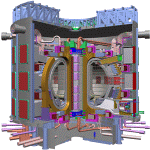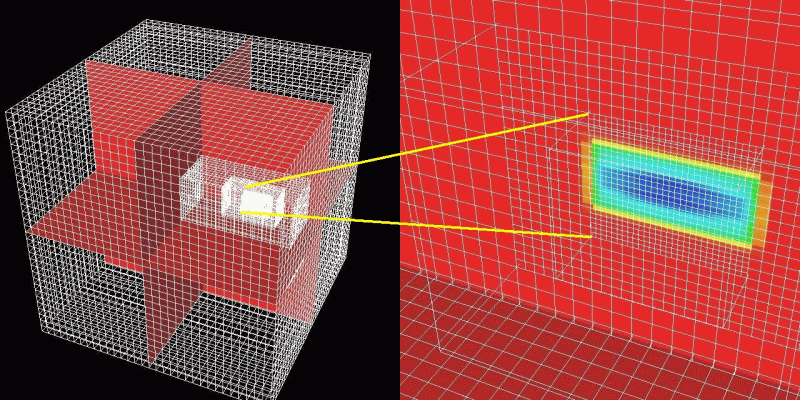
A schematic of the giant ITER fusion project under construction in Europe.
Ravi Samtaney knew computer resources beyond anything practically available would be required to run codes he designed to simulate a reactor the size of ITER, the international experiment to develop commercially feasible fusion energy.
So Samtaney, a research physicist at the Department of Energy’s Princeton Plasma Physics Laboratory, joined a bicoastal collaboration with the Advanced Numerical Algorithms Group at DOE’s Lawrence Berkeley National Laboratory (LBNL) near San Francisco.
The group specializes in algorithms – mathematical recipes – and software designed to efficiently simulate huge scales of time and space.
Fusion reactors seek to harness the process that powers the sun to bring clean, plentiful energy to Earth.
In the refueling scheme Samtaney modeled, pellets of frozen hydrogen isotopes smaller than a pencil eraser are shot into plasma more than six times hotter than the sun’s core. A donut-shaped chamber holds the superheated plasma with powerful magnetic fields.
The usual way to simulate such a process is to use data grids or meshes, which distribute discrete data points through the domain being modeled. By calculating what’s happening at each point, the computer paints a picture of the entire process.
Although trained in the similar field of computational fluid dynamics, Samtaney had to teach himself plasma physics when he started at Princeton five years ago.
But distributing points evenly through a space as large as ITER creates a huge computational problem. “There were two sets of scales that had to be resolved,” says Phillip Colella, leader of the Berkeley group. One was the huge plasma cloud; the other was the tiny pellet that converts to ionized gas.
“You can’t afford to use a uniform grid to resolve that small scale,” Colella says. “On the other hand, you need to resolve that small scale or you aren’t going to get the right answer.”
Samtaney developed algorithms modeling magnetohydrodynamics (MHD) – the interaction of magnetic fields with electrically conducting fluids, like plasmas. His codes depict how streaming electrons heat the tiny frozen fuel pellet.
He turned to Adaptive Mesh Refinement (AMR) to make those algorithms practical on a simulation the size of ITER. AMR conserves computer resources by focusing data points in the most interesting areas – around the pellet – and putting fewer points elsewhere.
Colella’s group has created a library of AMR algorithms called Chombo. With support from DOE’s Scientific Discovery through Advanced Computing (SciDAC) program, Samtaney worked with Brian Van Straalen in Colella’s group to adapt Chombo’s mesh algorithms for his simulation.
The result: The fusion refueling simulation ran several hundred times faster than it would have with a uniform mesh.
Without adaptive meshes, the program would have had to simulate a larger pellet, a smaller reactor, and a weaker magnetic field around the plasma, Samtaney says. Such a simplified simulation would have limited use.
The goal is to solve the engineering problem of refueling the fusion reactor, Samtaney says. But a more important goal is understanding how the pellet’s mass is distributed in the plasma.
“That kind of quantitative information would be very useful for ITER,” Samtaney says, but obtainable only with detailed simulation.
The collaboration was just as valuable for the Berkeley group, Colella says.
“There’s nothing like having a real problem, and a new real problem, something we haven’t done before,” to improve software, he adds. Besides making their codes more applicable, the fusion simulation helped expose areas where the codes slow.
“It is very valuable for us to get that kind of feedback, because then you can go and fix those problems,” Colella says.
Colella says Samtaney also succeeded in bringing a new approach to simulating physics. Although trained in the similar field of computational fluid dynamics, Samtaney had to teach himself plasma physics when he started at Princeton five years ago.
Now “I think he’s viewed as a member of the club” by the physicists he works with, Colella says.
Samtaney says those challenges are some of the best things about his job. Another is “I get to work with absolutely the best people in this business,” Samtaney adds. “Phil Colella and his staff members are the best.”
